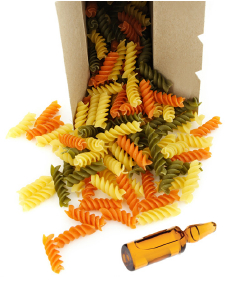You are here: Home  Technical Articles
Technical Articles  Food,Flavours & Fragrances
Food,Flavours & Fragrances  Accurately Determine Mineral Oil Hydrocarbons in Food
Accurately Determine Mineral Oil Hydrocarbons in Food
 Technical Articles
Technical Articles  Food,Flavours & Fragrances
Food,Flavours & Fragrances  Accurately Determine Mineral Oil Hydrocarbons in Food
Accurately Determine Mineral Oil Hydrocarbons in Food According to the German Federal Institute for Risk Assessment (BfR), mineral oil hydrocarbons (MOHs) may damage the liver, heart valves, and lymph nodes. Because the structure of some mineral oil hydrocarbons resembles that of PAHs, they may also be carcinogenic/mutagenic. These dangerous compounds can enter the food supply through farm and production equipment as well as printer ink, but in addition, current technology is unable to sufficiently remove mineral oil hydrocarbons from recycled cardboard. Once the cardboard is used for packaging, volatile hydrocarbons in mineral oils are then able to find their way into our food through gas diffusion.
According to the German Federal Institute for Risk Assessment (BfR), mineral oil hydrocarbons (MOHs) may damage the liver, heart valves, and lymph nodes. Because the structure of some mineral oil hydrocarbons resembles that of PAHs, they may also be carcinogenic/mutagenic. These dangerous compounds can enter the food supply through farm and production equipment as well as printer ink, but in addition, current technology is unable to sufficiently remove mineral oil hydrocarbons from recycled cardboard. Once the cardboard is used for packaging, volatile hydrocarbons in mineral oils are then able to find their way into our food through gas diffusion.
In short, accurate determination of mineral oil hydrocarbons in food is imperative; however, because they are comprised of aliphatic and aromatic hydrocarbons, analysis is difficult using standard methods. As a result, a special technique has been developed in Switzerland that uses LC coupled with GC-FID, and it is quickly gaining popularity throughout Europe and beyond.
In collaboration with its German subsidiary and labs in the EU, Restek has formulated a stock reference standard mix (cat.# 31070) specifically for the analysis of mineral oil saturated hydrocarbons (MOSH) and mineral oil aromatic hydrocarbons (MOAH).
This 9-component mix contains non-interfering internal standards as well as both MOSH and MOAH markers to correctly cut fractions for reliable results. Like all of the certified reference materials (CRMs) manufactured and QC-tested in Restek’s ISO-accredited labs, it can also help you satisfy your ISO requirements with ease.
With the release of this new CRM, Restek is proud to offer a complete solution for world-class MOSH/MOAH analysis, including Allure® silica LC columns, Rxi®-5Sil MS GC columns and accessories. Click here to find the answers to your MOSH/MOAH Challenges